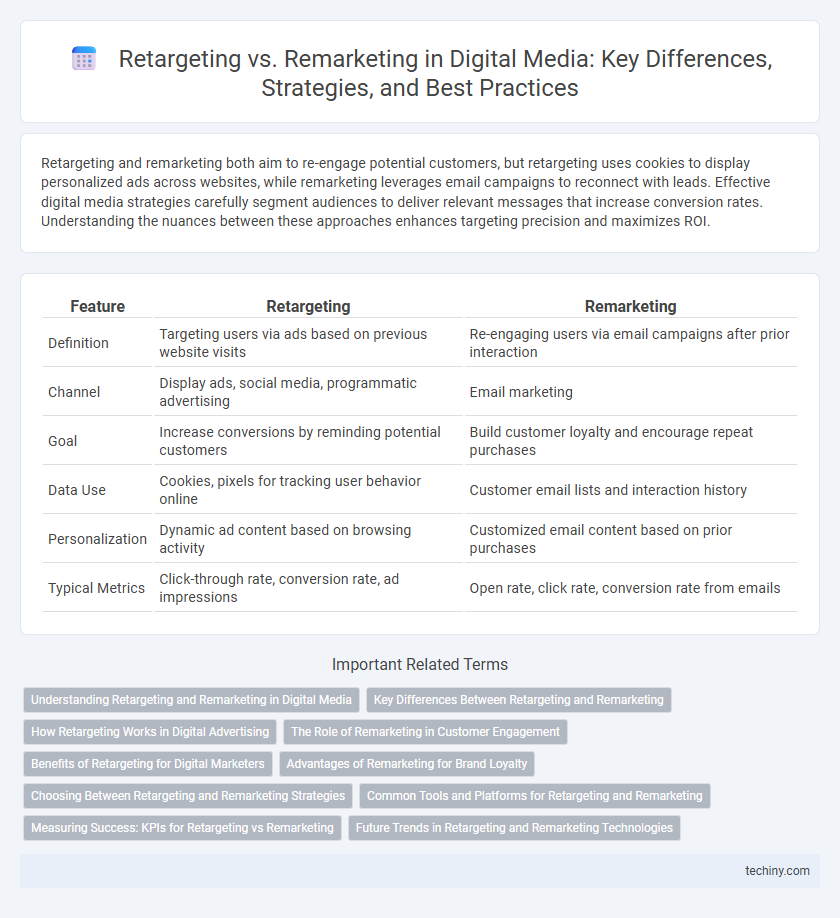Retargeting and remarketing both aim to re-engage potential customers, but retargeting uses cookies to display personalized ads across websites, while remarketing leverages email campaigns to reconnect with leads. Effective digital media strategies carefully segment audiences to deliver relevant messages that increase conversion rates. Understanding the nuances between these approaches enhances targeting precision and maximizes ROI.
Table of Comparison
| Feature | Retargeting | Remarketing |
|---|---|---|
| Definition | Targeting users via ads based on previous website visits | Re-engaging users via email campaigns after prior interaction |
| Channel | Display ads, social media, programmatic advertising | Email marketing |
| Goal | Increase conversions by reminding potential customers | Build customer loyalty and encourage repeat purchases |
| Data Use | Cookies, pixels for tracking user behavior online | Customer email lists and interaction history |
| Personalization | Dynamic ad content based on browsing activity | Customized email content based on prior purchases |
| Typical Metrics | Click-through rate, conversion rate, ad impressions | Open rate, click rate, conversion rate from emails |
Understanding Retargeting and Remarketing in Digital Media
Retargeting in digital media involves tracking users who have interacted with a website or content and serving them personalized ads across various platforms to drive conversions. Remarketing typically refers to reconnecting with existing customers or email subscribers through targeted campaigns, often via email marketing or customized ads. Both strategies aim to increase engagement and conversions by targeting users based on their previous behavior and interactions with the brand.
Key Differences Between Retargeting and Remarketing
Retargeting uses online ad placements to target users who have previously visited a website, leveraging cookies and pixel tracking for dynamic ads across platforms. Remarketing primarily involves re-engaging email subscribers or customers through targeted email campaigns based on past interactions and purchase history. Retargeting relies on paid media networks like Google Ads, while remarketing focuses on owned channels such as email lists for personalized, direct communication.
How Retargeting Works in Digital Advertising
Retargeting in digital advertising works by tracking users who have previously visited a website or interacted with a brand online using cookies or pixel tags. These technologies collect anonymous data, enabling advertisers to display personalized ads to these users across various platforms like social media, search engines, and display networks, increasing the chances of conversion. This approach improves ad relevance by targeting warm leads, ultimately enhancing return on ad spend (ROAS) for digital marketing campaigns.
The Role of Remarketing in Customer Engagement
Remarketing plays a crucial role in customer engagement by targeting users who have previously interacted with a brand, delivering personalized ads that reinforce brand recall and encourage conversion. By leveraging data from past user behavior, remarketing campaigns create highly relevant touchpoints that nurture leads through the sales funnel. This strategy enhances customer loyalty and maximizes return on ad spend by maintaining continuous communication with engaged audiences.
Benefits of Retargeting for Digital Marketers
Retargeting offers digital marketers the benefit of increasing conversion rates by targeting users who have already expressed interest in their products or services, leading to higher engagement and reduced acquisition costs. By leveraging dynamic ads based on user behavior, retargeting enhances personalization and relevance, which boosts click-through rates and overall ROI. This strategy allows marketers to efficiently recapture lost prospects and nurture them through the sales funnel with precise audience segmentation.
Advantages of Remarketing for Brand Loyalty
Remarketing leverages personalized ad campaigns to re-engage previous website visitors, significantly boosting brand loyalty by reinforcing customer connections through tailored messaging. By targeting users based on their specific interactions and preferences, remarketing enhances conversion rates and fosters long-term relationships. This strategy improves customer retention and strengthens brand recall, ultimately increasing lifetime value and promoting sustained engagement.
Choosing Between Retargeting and Remarketing Strategies
Retargeting uses cookies to track users' online behavior and serves personalized ads to re-engage potential customers who visited a website but did not convert. Remarketing typically involves email campaigns targeting existing customers or leads to nurture relationships and encourage repeat purchases. Choosing between retargeting and remarketing depends on campaign goals, audience data availability, and channels, with retargeting excelling in ad network precision and remarketing fostering direct communication via email lists.
Common Tools and Platforms for Retargeting and Remarketing
Common tools for retargeting include Google Ads, Facebook Ads Manager, and AdRoll, leveraging pixel tracking to re-engage website visitors through display and social media ads. Remarketing platforms often utilize email marketing services like Mailchimp and Klaviyo to reconnect with users by sending personalized email campaigns based on prior interactions. Both strategies frequently integrate CRM systems and analytics tools such as HubSpot and Google Analytics to optimize audience segmentation and campaign performance.
Measuring Success: KPIs for Retargeting vs Remarketing
Measuring success in retargeting versus remarketing hinges on specific KPIs like click-through rates (CTR) and conversion rates for retargeting campaigns, highlighting user re-engagement with ads. Remarketing metrics prioritize customer lifetime value (CLV) and average order value (AOV) to assess the impact on long-term customer relationships. ROI and cost per acquisition (CPA) remain critical for evaluating overall campaign efficiency across both strategies.
Future Trends in Retargeting and Remarketing Technologies
Future trends in retargeting and remarketing technologies emphasize AI-driven personalization and advanced data analytics to enhance user engagement and conversion rates. Emerging tools leverage machine learning algorithms to deliver dynamically tailored ads across multiple platforms, increasing relevance and reducing ad fatigue. Privacy-centric innovations such as contextual targeting and decentralized data processing are gaining momentum to comply with evolving regulations while maintaining campaign effectiveness.
Retargeting vs Remarketing Infographic

 techiny.com
techiny.com